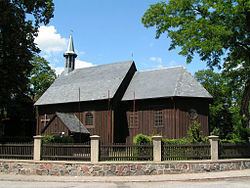Country Poland | County Żnin Population 1,400 Local time Monday 2:21 AM | |
 | ||
Weather 1°C, Wind N at 5 km/h, 79% Humidity Voivodeship Kuyavian-Pomeranian Voivodeship | ||
Gąsawa [ɡɔ̃ˈsava] (German: Gonsawa, 1939–45 Gerlingen) is a village in Żnin County, Kuyavian-Pomeranian Voivodeship, in north-central Poland. It is the seat of the gmina (administrative district) called Gmina Gąsawa. It lies approximately 10 kilometres (6 mi) south of Żnin and 43 km (27 mi) south-west of Bydgoszcz. The village has a population of 1,400.
Map of G%C4%85sawa, Poland
Gąsawa received the city rights in 1388 and lost them in 1934.
It is famous as the place of the assassination of Leszek I the White, prince of Poland (November 23, 1227).
In 1600 Gąsawa hosted the Lubrański Academy (Polish: Kolegium Lubrańskiego) which temporarily moved out of plague-stricken Poznań.
The main tourist attraction in Gąsawa is the 17th century wooden St. Nicolas Church with a unique collection of multi-layered mural paintings, the earliest from the 17th century, and the most recent from 1807.
The church itself, a larch construction with a slate roof, was in such a bad state around 1850 that local officials asked the regional Prussian government to allow the church to be dismantled and build a new one instead. The response gave permission to only overhaul the building. Existing wall paintings were covered with a layer of reed and ordinary plaster, and forgotten for some 150 years.
The town name was spelled "Gonzawa" "Gonsawa", "Gassawa", etc. in some old documents.
